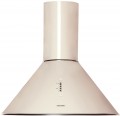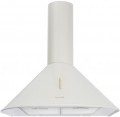Motor power
The power of the hood at maximum speed.
The more powerful the device, the more performant it is, usually. However, there is no rigid dependence here, and hoods of the same power may differ in actual performance. So it is worth evaluating power consumption in terms of power first of all: the lower this indicator, the more economical the device. And when evaluating performance, you need to look not so much at power as at the directly claimed flow of the air (see below).
Flow of air (motor)
The maximum flow of air or motor flow of air indicates the theoretical capability of the device. This parameter of the hood (motor) is measured during idle operation. By connecting the duct and working in the appropriate mode of extraction, the flow of air will be lower. However, high-performance motors will also give a high flow of air in extraction mode.
Max. noise level
The level of noise produced by the hood in the loudest mode of operation. Usually (but not necessarily) it is the maximum power mode. It affects the comfort during operation of the device, so
quiet hoods will be more preferable, but also more expensive.
The decibels in which the noise level is measured are non-linear units, so it is easiest to use comparison tables to estimate a specific value. Here is the simplest table for the values relevant in this case:
— 35 dB. The volume of a conversation in an undertone (but not a whisper). The lowest maximum noise value in modern hoods. Devices with such characteristics are almost guaranteed not to cause inconvenience: such noise is often blocked by other sounds, for example, the background noise of the street in an open window.
— 40 dB. The volume of a normal conversation. The maximum noise level allowed in a residential area during the day. If the hood is bought for home use, and it is supposed to be turned on often and for a long time, the noise level in the selected device shouldn't exceed this indicator.
— 50 dB. Conversation volume at medium tones.
— 60 dB. Raised conversation.
— 70 dB. Sound background on a busy street, in a crowd of people talking loudly, the sound of a vacuum cleaner motor at a distance of 2 – 3 m.
— 75 dB. Scream or loud laughter at a distance of about a metre.
— 78 – 79 dB. Loud mechanical alarm clock, motorcycle o
...r truck engine. The highest level in modern consumer-grade hoods.
Note that the actual comfort of using the device depends not only on the volume but also on the timbre (tonality) of the noise: for example, a low, even rumble is generally perceived easier than high frequencies with clanging notes. If the hood installation is unsuccessful, the actual noise level may be higher than stated in the specifications. For example, additional noise can be caused by the hum of air in the ducts or rattling from the contact of the vibrating body with the wall. However, when choosing, it is worth focusing on the noise level claimed in the specifications.Carbon filter model
The model of the carbon filter compatible with the hood. For more information about such a filter, see "Ability to install carbon filter". Here we note that the carbon filter is not always supplied in a kit, and its service life is limited, periodic replacement is required. Anyway, the data on the filter model makes it much easier to find.
Lighting
Lighting method provided as standard in the hood.
— Incandescent lamp. The simplest and most affordable of modern lighting sources. The main advantage of incandescent lamps is their low cost. In addition, they give a fairly eye-pleasing light in warm colours. On the other hand, such lamps are the most energy-intensive. Besides, they get very hot during operation.
— Halogen lamp. An improved version of the incandescent lamps described above. They are distinguished by higher brightness at lower power consumption while also having a spectrum of luminescence that is pleasing to the eye. At the same time, halogen lamps are still inferior in terms of efficiency to fluorescent and LED lamps.
— Fluorescent lamp. Also known as "fluorescent light bulbs" or "energy-saving light bulbs". One of the advantages of such lamps is just low power consumption — many times lower than that of incandescent lamps (although higher than that of LEDs). The light from fluorescent lamps is white, rather cold; this can be both an advantage and a disadvantage, depending on personal preferences and interior features. But of the unambiguous shortcomings, it is worth noting that most of these lamps contain mercury vapour in the flask; because of this, failed light bulbs must be disposed of according to special rules, and a broken lamp can become a source of health problems.
—
Light-emitting diodes (LED). The most advanced of mod
...ern lighting sources. LEDs are highly energy-efficient. They are more economical than incandescent lamps, and they practically do not heat up during operation. The light from such sources is neutral white, which is quite suitable for most cases. The disadvantage of LEDs is a rather high price.
Note that many modern hoods allow you to replace a regular light source — for example, a halogen lamp can be changed to a fluorescent or LED lamp with the same base.Height (min)
The minimum height of the entire hood structure is from the lower edge to the upper part of the body (the point of connection of the external air duct). This parameter is indicated only for hoods with an adjustable design that allows you to change the height. Pay special attention to the minimum height if the device is planned to be installed in a kitchen with a low ceiling. In this case, it should be assumed that the optimal height of the air intake above the hob is 60-80 cm, and between the hood body and the ceiling, a headroom is required for the air duct. With a low ceiling, a hood that is too large may simply not fit into your kitchen.
Height (max)
The height of the entire hood structure is from the lower edge to the upper part of the body (the point of connection of the external air duct). For hoods with an adjustable design that allows you to change the height of the case, the maximum height is the size of the device in the unfolded state; in the case of non-adjustable hoods, this means a correspondingly constant overall height. When choosing a hood in height, it is worth proceeding from two points:
1. The optimal height of the air intake above the hob is 60-80 cm. This height allows the hood to capture kitchen fumes effectively and, at the same time, gives enough space to work with the hob.
2. Between the hood body and the ceiling, a clearance is required for connecting an external air duct.

